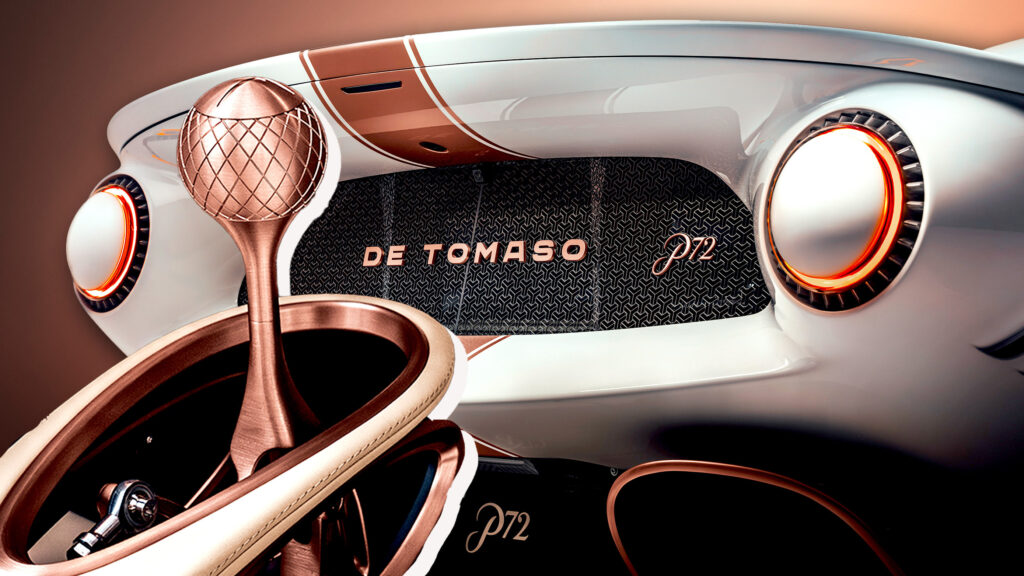De Tomaso’s New Supercar Is A Manual Love Letter To Drivers


- De Tomaso has unveiled the first internal production-spec P72, marking a key milestone.
- The new supercar is finished in white and copper, distinct from the 72 customer units.
- Deliveries of the manual-only model will commence in late 2025, a year later than planned.
It’s been a long time in the making, but De Tomaso Automobili has finally delivered the first production-spec De Tomaso P72 supercar, nearly six years after the debut of the original concept. This milestone marks the completion of a long journey, and though it may have taken longer than expected, the end result is undeniably impressive.
var adpushup = window.adpushup = window.adpushup || {que:[]};
adpushup.que.push(function() {
if (adpushup.config.platform !== “DESKTOP”){
adpushup.triggerAd(“0f7e3106-c4d6-4db4-8135-c508879a76f8”);
} else {
adpushup.triggerAd(“82503191-e1d1-435a-874f-9c78a2a54a2f”);
}
});
More: New Retro Barchetta Looks Like Italy But Roars Like Detroit
The P72 you’re seeing here that’s codenamed DT0001, doesn’t belong to any of the 72 customer allocations that will follow. Instead, this particular example is an “internal production specification unit,” crafted to showcase the final design, engineering, and build quality of the limited-production supercar. If you’re hoping to snag one for yourself, you’ll have to wait your turn, but at least you know what you’re getting.
A Nod to the Past, with Modern Flair
The design of the P72 stays almost identical to the concept that wowed crowds at the 2019 Goodwood Festival of Speed. The supercar retains its low-slung silhouette, sculpted lines, and retro-inspired styling that first captured the imagination of enthusiasts. The most noticeable differences from the concept are subtle: functional window cutouts and a redesigned rear diffuser that should improve aerodynamics (or at least make it look faster when parked).
The P72 is also advertised as a spiritual successor to the 1965 De Tomaso P70, a racing car designed by Alejandro De Tomaso and Carroll Shelby. While it may trace its lineage to the P70, many observers have pointed out its resemblance to iconic Italian models from the past, like the 1966 Ferrari 330 P3 and the famed 1967 Alfa Romeo 33 Stradale.
As Personal as You Want, Just Don’t Ask for Screens
The P72 offers plenty of ways to make it your own. You can choose from heritage-inspired paint finishes, a naked carbon exterior, or a variety of hand-stitched leather and machined metal finishes inside the cabin.
var adpushup = window.adpushup = window.adpushup || {que:[]};
adpushup.que.push(function() {
if (adpushup.config.platform !== “DESKTOP”){
adpushup.triggerAd(“bb7964e9-07de-4b06-a83e-ead35079d53c”);
} else {
adpushup.triggerAd(“9b1169d9-7a89-4971-a77f-1397f7588751”);
}
});
The example pictured here features a white exterior with copper accents, and matching copper wheels that probably cost more than most people’s cars. Inside, the combination of cream leather, copper highlights, and a bit of carbon fiber suggests that De Tomaso is not just going for a performance car, but also a moving work of art.
And in an interesting (or perhaps nostalgic) twist, the interior avoids the temptation of touchscreens. Instead, you’ll find analog dials and rotary switches for the controls, proving that some manufacturers still believe in the tactile pleasure of turning a knob rather than poking a screen.
A Supercharged V8 From America And Carbon Chassis

Unlike the concept model, which featured a V12 engine from the Apollo Intensa Emozione, the production De Tomaso P72 is powered by a supercharged 5.0-liter V8 sourced from Ford. Developed in partnership with Roush, the engine features custom-forged internals and a 60s-inspired header design.
var adpushup = window.adpushup = window.adpushup || {que:[]};
adpushup.que.push(function() {
if (adpushup.config.platform !== “DESKTOP”){
adpushup.triggerAd(“b25ecba7-3bbb-4ea7-a3a8-dbea91695c07”);
} else {
adpushup.triggerAd(“e46c436a-adeb-4b5e-a2c7-56bc36561c10”);
}
});
The engine produces a respectable 700 hp and 820 Nm (605 lb-ft) of torque. Power is sent to the rear wheels exclusively through a short-ratio six-speed manual gearbox, which is another welcome change from the sea of automatics plaguing the supercar realm these days
More: The Exhaust Of The De Tomaso P900 Looks Like A Piece Of Art
In the same spirit, De Tomaso has also chosen to skip the modern obsession with endless drive modes. Instead, it’s all about simplicity, with an emphasis on raw, unfiltered performance. The P72 is built on a bespoke carbon fiber chassis with a central monocoque, front and rear subframes, and an optimal weight balance that promises to deliver a pure, analog driving experience.
Add in the pushrod suspension and three-way manually adjustable dampers, and you have a supercar that’s as much about the feel of the road as it is about speed.
Deliveries To Start Later This Year
After years of development, De Tomaso plans to begin deliveries of the P72 in late 2025, a year later than initially announced. Pricing is still unconfirmed, but earlier reports suggest it’ll start at around €1.6 million ($1.8 million). While that’s certainly a lot of money for a car, you can take comfort in knowing it’s as exclusive as it gets.
As for the track-only De Tomaso P900, which was unveiled in 2022 with a production run of just 18 units and a price tag of $3 million, the company has remained tight-lipped about its status. Perhaps they’ve learned that not everything needs to be said out loud, especially when it involves cars that most of us will never get to see, let alone drive.
Norman Choi, CEO of De Tomaso Automobili, stated: “The P72 was our promise to faithfully revive a historic marque. This first production-specification vehicle embodies everything we stand for: a mechanical soul, timeless beauty, and a driving experience that rises above modern convention. It is our echo through time – now made real.”